When it comes to LinkedIn Ads costs, spend varies a lot depending on a series of factors: the location, the language, the company size, the kind of business, the industry… But one thing that can make or break your pay-per-click strategy is the way you set your campaign up.
In the digital marketing trade, it’s common to hear that LinkedIn ads are expensive considering the cost per click. However, as you most likely know, business is not always about price – it is also about value. How can you put a price on new, hot leads for your business? Are those leads easy to get from LinkedIn?
LinkedIn is a great place to find new B2B prospects. Not only is it a platform that aims at professionals, it is also a social network that is permeated by brand messages with no resistance from users. After all, we’re on LinkedIn to do business. The power of this platform cannot be neglected if you want to sell your B2B service. However, the time and money invested on LinkedIn need to be reasonably balanced with results.
Therefore, should you go for a LinkedIn Ads agency rather than go it alone? We recommend using an agency, because LinkedIn Ads require a knowledge of the platform that not all entrepreneurs have beforehand. In this article, we’ll go through how to set up a campaign on LinkedIn Ads, and what you should expect from it. So, without further ado, let’s dive in!
Key takeaways
- Monitor and Adjust Bids Regularly – Keep an eye on your daily spend versus your budget. If your spend is exceeding your budget, lower your bids. If you’re underspending, consider increasing them to optimize your campaign’s reach.
- Use CPC for Website Visits, Not CPM – To better control costs, choose the “Website Visits” campaign objective, which uses the CPC model. Avoid the “Brand Awareness” objective, which is charged on a CPM basis and can drive up costs.
- Refine Targeting with Exclusions – Layer exclusions into your campaign. If there are specific job titles or industries that aren’t relevant or performing poorly, exclude them to avoid wasting your budget.
- Monitor Demographics and Adjust – Review demographic reports to spot industries with high impressions but low clicks. Adjust or remove those industries to ensure your ads are resonating with the right audience and not overspending on irrelevant segments.
1 – How much does it cost to advertise on LinkedIn?
To give you a general idea of how much does do LinkedIn Ads cost, we’ll share with you the average CPC, CPM and CPS.
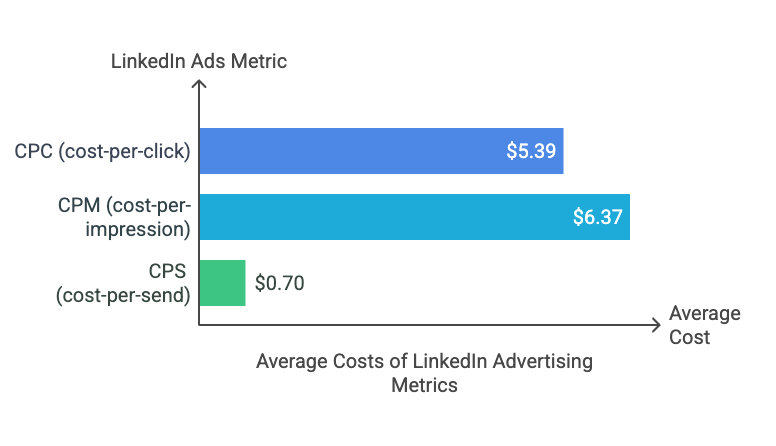
- The average CPC (cost-per-click) on LinkedIn is around $5.39. Depending on your budget, this might be a bit expensive, but remember these clicks come from users that can easily turn into qualified leads. But not all campaigns on LinkedIn are measured by CPC. Other campaigns use CPM (cost per impression, which means the cost of a thousand impressions), which might fit your business better if you are looking to make your brand known. These campaigns aim at larger target audiences and do not always lead to clicks. They are a great alternative to CPC for brand awareness before lead generation.
- The average CPM (cost-per-impression) in LinkedIn campaigns is $6.37. Even though it seems like you are paying more, you end up paying less than with CPC – remember you pay for users to see your content rather than clicks.
- Now, finally, CPS (cost-per-send) is another different metric. It applies to InMail messages that you can send to your target audience. This means that you pay to get directly in touch with users on their LinkedIn inbox. Cost per send means that for every message sent, you pay an average of $0.70. Even if the user never checks their inbox or just decides to ignore it. InMail is also great for bottom of the funnel campaigns – typically, users that have some knowledge of the industry and could be interested in what you have to offer.
2 – LinkedIn Ad Pricing Models
As you gathered from the previous section, not all ads are measured equally on LinkedIn. This means there are several ad pricing models you can use, which relate to the way to measure costs and performance.
So, as we mentioned previously, there are three LinkedIn Ad Pricing Models: CPC, CPM and CPS. In this section, we’ll further explain how each of them works and which apply for different types of LinkedIn Ads.
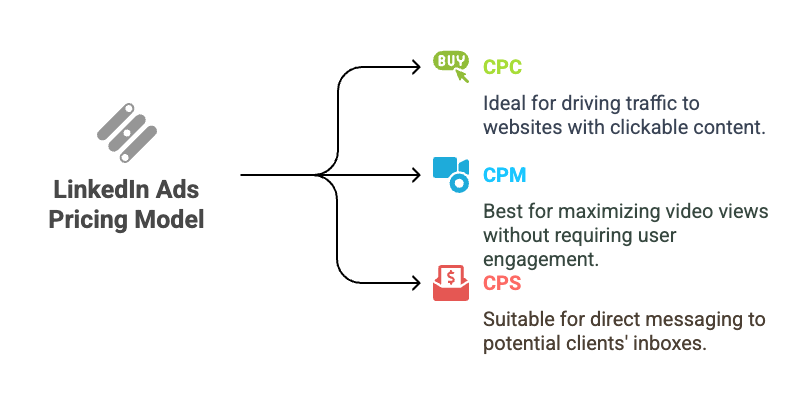
- CPC
You can use cost per click in both Sponsored Content and Text Ads. You pay for each click, which means these campaigns are meant to drive traffic to a website or your landing page. This can mean videos, pictures, and, of course, Text Ads. You get to choose what you think will interest your target audience.
- CPM
Cost per impression is also used in Sponsored Content and Text Ads. Videos tend to perform better when using CPM, as you can just pay for users to watch your videos without the need to engage. Text ads can also be used with a CPM pricing model, but we typically don’t recommend it since this kind of ad tends to target engagement and action on the part of the user.
- CPS
For Sponsored InMail, LinkedIn charges a cost per send. You are paying to get to the inbox of potential clients or customers, and the price, although a bit steep, is reasonable to get to message your target audience directly.
The potential of this pricing model is great, but it can also easily go wrong if you miss the right audience or if there is something wrong with the messaging. The fact that these are direct messages can amplify any mistake, and as you know, the Internet never forgets.
3- How Does LinkedIn Charge for Ads (+ Tips to Spend Less)
Understanding how LinkedIn charges for ads will give you an edge in controlling your costs. Most marketers think they know how CPC works, but LinkedIn’s “chargeable click” system is more complex than it appears.
What is a “Chargeable Click”?
A chargeable click in LinkedIn Ads is basically an action that LinkedIn will charge you for as if it is a click when you are bidding on CPC. The chargeable clicks differ depending on the objective and the ad type, which is why your costs can vary dramatically between similar campaigns.
Understanding Chargeable vs Non-Chargeable Clicks
Here’s exactly what you get charged for with different campaign objectives:
Click Type | Clicks On | Website Visits | Engagement | Lead Generation |
|---|---|---|---|---|
| Landing Page | Intro text, ad image, headline, or CTA | ✅ CHARGED | ✅ CHARGED | ✅ CHARGED |
| Lead Gen Form | CTA button | N/A | N/A | ✅ CHARGED |
| Conversation Asset | Intro text, ad image, headline, or CTA | ✅ CHARGED | N/A | ✅ CHARGED |
| LinkedIn Page | Logo, company name, intro text, social proof | ❌ FREE | ✅ CHARGED | ✅ CHARGED |
| Social Pill | Social engagement indicators | ❌ FREE | ✅ CHARGED | ✅ CHARGED |
| Social Actions | Likes, comments, shares, hashtags | ❌ FREE | ✅ CHARGED | ❌ FREE |
| Member Page | Social proof header | N/A | ✅ CHARGED | N/A |
| Open More Content | “See more” text | ❌ FREE | ✅ CHARGED | N/A |
| Subscribe | Subscribe button | N/A | ✅ CHARGED | N/A |
| View Email | Email link from intro text | N/A | ✅ CHARGED | N/A |
| Save Article | Save button | ❌ FREE | ✅ CHARGED | N/A |
| LinkedIn Company Follows | +Follow button | N/A | ✅ CHARGED | N/A |
| Video | Media, headline, CTA, or video | N/A | N/A | ✅ CHARGED |
Expert Tip: We usually prefer Document ads over carousel ad format for various reasons. First, if different carousel cards have separate destination URLs, you’re charged once for each unique URL the member clicks. Also, you can’t use carousel engagers for your retargeting audience.
Engagement Objective (Higher Costs)
When running the same Single Image ad as an Engagement Objective, you’ll get charged for everything, including all of the above, plus:
- Clicks to the LinkedIn Page
- Social pill (seeing who liked or commented)
- Social actions (likes, comments, shares, reactions)
- Clicks to hashtags
- Member page (clicking on someone else who engaged with your ad)
- Open more content (clicking “see more”)
- Page follows
- Save article
Lead Generation Objective (Most Expensive)
Here’s why Lead Gen campaigns are so expensive – you pay for almost every action:
- Click on the company page? Charged.
- Opened the form? Charged.
- Clicked too hard on “See more”? Charged.
- Social actions (likes, comments, shares)? Charged.
- Page follows? Charged.
- Member profile clicks? Charged.
This means you’re paying for a lot of actions that don’t result in actual form submissions, making Lead Gen campaigns significantly more expensive per actual lead.
Tips to Spend Less
1. Always Use Website Visits Objective for Traffic This is the most cost-effective way to drive traffic since you only pay for clicks that actually send users to your website.
2. Avoid Engagement Objective Unless Necessary Unless you specifically need social engagement, avoid this objective as it charges for actions that don’t drive business value.
3. Monitor Your Click Types Review your campaign reports to see what types of clicks you’re getting charged for. If you’re seeing lots of non-valuable clicks, consider adjusting your objective or ad format.
4- How Much Should You Spend on LinkedIn Advertising?
One of the most common questions we get from B2B companies is about budget allocation for LinkedIn ads. The answer depends on your experience with the platform, your business goals, and whether you’re just starting out or scaling proven campaigns.
Starting Budget for Lead Gen campaigns: Test Before You Scale
If you don’t have any historical data or past performance to reference, I wouldn’t recommend breaking the bank during the first weeks of testing, especially if you don’t know which messages and offers work best for your audience.
For beginners targeting a cold audience, I recommend starting with:
- $20 to $40 maximum daily budget per campaign during the testing phase
- Focus on gathering data and testing various creatives and audience combinations
- After 2-3 weeks, pause underperforming campaigns and scale the best ones
- As soon as you find a campaign that consistently generates leads, gradually increase the daily budget and monitor if you can maintain your cost per lead
This conservative approach prevents you from burning through budget on unproven campaigns while giving you enough data to make informed decisions.
For lead gen only: I recommend starting with a $1,500/month budget minimum.
Full-Funnel Strategy: Established Budget
Once you’ve validated your approach or if you have a proven strategy, you can scale your LinkedIn Ads budget with the full-funnel strategy (Demand gen + lead gen). In this case, you can start with a $3,500/month budget minimum.
Here’s why: LinkedIn Ads work best as a full-funnel platform, especially if you’re targeting big organizations with high-ticket deals and long sales cycles. You need to create a balanced strategy between demand capture and demand generation:
Top-of-Funnel Campaigns (Demand Generation) – 60-70% of Budget
Most of your budget should go to demand generation campaigns with content that builds trust and brand equity. This includes:
- Brand awareness videos
- Ungated educational content (reports, whitepapers, industry insights)
- Thought leadership content
- Educational webinars and case studies
Why this matters: Most B2B buyers aren’t ready to purchase immediately. You need to stay top-of-mind during their research phase.
Expert Tip: Instead of spending $50/day on a single Demand gen campaign, diversify. For example if you’re running a single image ad, launch a complementary document ad using the same asset. Split the budget across both (e.g., $25 + $25). A video view campaign for Brand awareness combined is also a good format to amplify your reach other than single image.
Bottom-of-Funnel Campaigns (Demand Capture) – 30-40% of Budget
Use this portion of your budget for ads focused on conversion, addressing objections, and reinforcing credibility:
- Product-focused ads with problem/solution messaging
- Content showing how you’re different from competitors
- Social proof and testimonial ads
- “Book a demo” or “Contact us” campaigns
- Free trial or assessment offers
Important Considerations
Don’t scale too quickly: If you increase budgets by more than 50% at once, LinkedIn’s algorithm tends to increase the cost per lead. Better to scale slowly with a 25% maximum for a couple of weeks.
Monitor your audience saturation: If your cost per click starts increasing significantly as you scale, you might be reaching audience saturation or need to refresh your ads messages and creatives.
Industry and seniority factors: Highly competitive industries (tech, finance, consulting) and seniority ( Director, VP, CXO, owners) typically require higher budgets to compete effectively in the auction.
Remember, these are starting recommendations. Your actual budget should align with your customer lifetime value, sales cycle length, and overall marketing budget allocation.
5 – Controlling ad spend
When it comes to controlling ad spend, you can use different options on LinkedIn. We recommend using manual bidding options. LinkedIn’s automated bidding is easier, but there are other options such as manual, target cost, and max delivery.
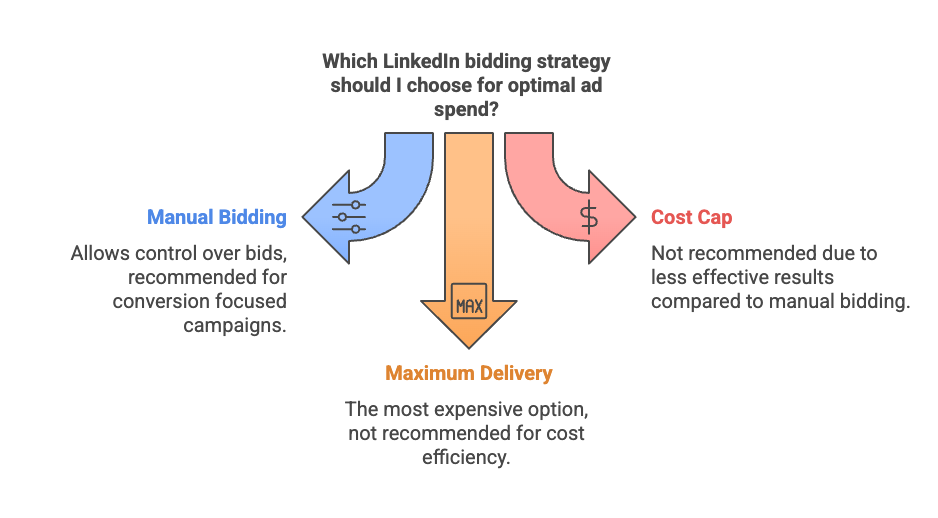
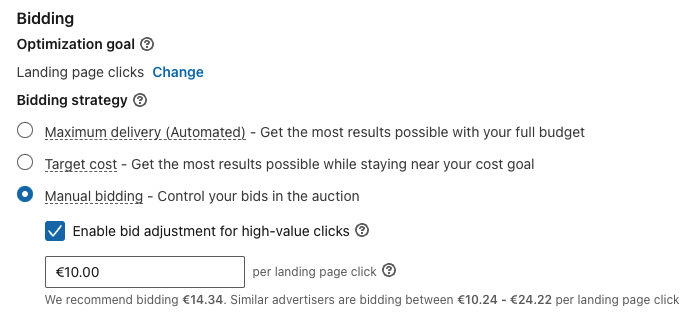
- Manual bidding
It allows you to set a price for each click, each thousand impressions, and each send. This is the best option to choose as it provides an ideal control over how much you are spending on your campaign. Bid prices can vary a lot, and by using manual bidding you are defining how much you want to spend on each bid.
Expert Tip: If you use manual bidding, the standard tactic is to bid low to get the cheapest clicks. However, if your audience is broad, the budget will prioritize the cheaper (junior) audience. Be sure to monitor your demographic reports in order to see if you are targeting the relevant seniority segments to reach your ICP (Ideal Customer Profile).
- Cost Cap
In this option, LinkedIn automatically adjusts your bid according to your target bid price. We recommend this option once you have created your full campaign, know what you’re doing and how to optimize. You should have an exact target goal in mind when using target cost, as it enables you to control how much you are spending towards your goal. At the same time, it allows you to optimize for performance.
Expert Tip: I don’t recommend this type of bidding, since any time we have tested “Cost Cap” against manual bidding for our clients, the latter gives better results.
- Maximum delivery
If you have a high daily budget, we suggest using max delivery. It will aim at spending your budget faster for maximum results. This is a great tactic if you don’t have time to optimize a lot and want quick results. Bid management can also be automated using the max delivery option.
Expert Tip: I don’t recommend this bidding strategy either. Maximum delivery bidding is typically the most expensive way to pay for traffic on LinkedIn about 90% of the time. It allows LinkedIn to bid as high as necessary on a CPM (cost per thousand impressions) basis to spend your daily budget.
Now that you know how to set your ad spend, let’s go through the steps that you need to take in order to create your first campaign.
5 – How to create your LinkedIn advertising campaign
Creating a campaign for LinkedIn is not simple, but we’re going to help you understand the process a bit better. Follow the steps and you’ll know how LinkedIn campaign set up works so that, even if you use an agency, you will know how to guide your strategy.
Step 1 – Types of ads available on LinkedIn
There are four main types of ads you can use on LinkedIn.
- Sponsored content. These ads show videos, text, images or links. The ad buyer supplies the content and the ads show for users within the selected target audience. This content can be paid for using CPC (cost per click) or CPM (cost per thousand impressions).
- Text ads. These ads are less flashy when it comes to looks, and also tend to be lower in conversions than sponsored content. These are display ad banners that can appear in the user interface in different places. They are mostly used to aim for brand awareness.
- Sponsored InMail. This kind of ad is straight to the point: users get the ads in their LinkedIn inbox, and they appear as a normal message you would get from another user, apart from the “sponsored” tag. Sponsored InMail messages can be quite effective as they are tailored to a precise target audience. InMail campaigns are the only ones that are charged through CPS (cost per send).
- Dynamic ads pose an interesting challenge: how can you tailor your message in order to target users effectively? This kind of ad uses personalization to get closer to the target audience. We always prefer to be directly addressed. However, if overdone, dynamic ads can be annoying. There’s a delicate balance to it.
- Thought leader ads. They allow users to post and promote ad content from their employees’ LinkedIn profiles, as opposed to from the brand’s own page exclusively.
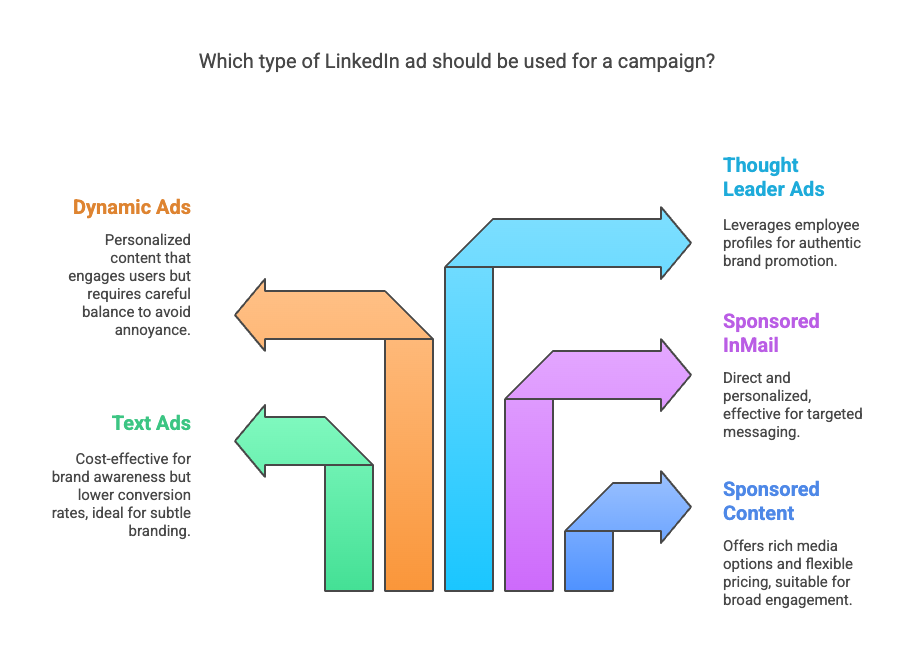
Expert Tip: You should always run some text ads because they are pretty much free advertising. They tend to get a very low click-through rate with an average of about 0.02% but they generate a high volume of impressions. Even though people aren’t clicking on those small ads on the right-hand side very often they are seeing them which increase your visibility and Brand exposure. Make sure you use the campaign objective website visits and not brand awareness as website visits is CPC pricing model and brand awareness is CPM pricing model.
Step 2 – Set your targeting options
After you’ve chosen the type of ad that you think will resonate with your audience, you need to set up your targeting. There are many things you can target, such as company size, industry, job title, job seniority, skills, schools, degree, field of study… You can even target a single company if you want to.
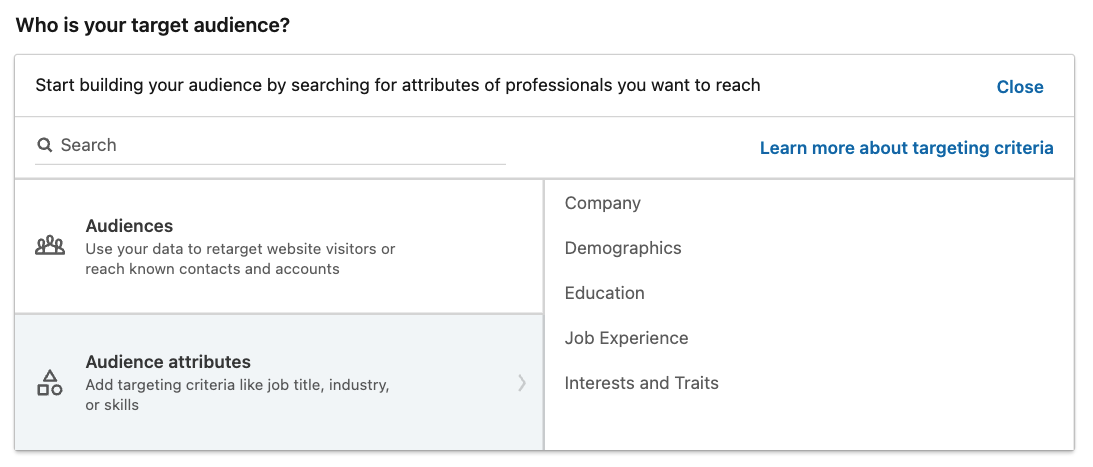
There are hundreds of targeting options you can use to set up your target audience. But, of course, you need to be aware of who you want to target and that will define which options you use. In the next step, we’ll discuss how to define your target audience.
Step 3 – Choose a target audience
When it comes to targeting professionals, LinkedIn is almost perfect. Once you have an idea of how does your audience looks – let’s say, their industry, age and gender, education and experience, interests… – it’s easy to set up a campaign that targets precisely the kind of user you already know should be interested in your product or service.
LinkedIn allows you to reach for users according to a lot of targeting options. At the same time, there are a lot of categories in the LinkedIn community that would not be as easy to find in other platforms (say, Facebook or Instagram).
The fact that LinkedIn is a business network makes it easier to find professionals that would use your B2B product. If you’re just getting started with LinkedIn, it’s important to try different approaches and different targeting options. Optimizing constantly is the best way to make sure you’re speaking to the right audience, and reaching out for users that fit your business offer.
Expert Tip: To optimize your campaign’s cost, make sure to monitor demographic reports regularly and adjust your targeting as needed. For example, if you notice an industry receiving high impressions but low clicks, investigate the reasons. It could be that the ads aren’t resonating with that audience, or it might be worth removing the industry from your targeting altogether. Additionally, don’t rely solely on inclusions—be sure to use exclusions too. If you’re targeting by job function, but there are specific job titles that shouldn’t see your ads, make sure to exclude them to refine your audience even further.
Case Study: How We Helped Kodo Survey to Generate 167% More Leads in 3 Months Using LinkedIn Ads
Step 4 – Create a budget
Budgeting on LinkedIn is not easy, but there are some tips that can help. By now, you already know you can use CPC, CPM or CPS pricing models to use your LinkedIn ads budget. You also know that you can set your budget to be spent in a few different ways: total budget (spend all at once), daily budget (for long term campaigns) and setting bids (to control how much you pay for each click).
LinkedIn recommends using a budget of $5000 per month for your advertising on the platform. You can set it up as a total budget and get it spent quickly, or you can set a budget of $150 per day. These options imply different strategies: the first one aims at reaching as many users as possible in a short period of time, whereas the second is the best for a slow and steady approach. Controlling you budget and LinkedIn ads billing is key to get maximum results.
Also, you should split your budget according to the 70/30 rule. This means that 70% of your budget should be targeting conversions and website traffic (using CPC or CPS – or both), and 30% should be spent on building brand awareness for your company (using CPM).
These approaches might not work the same for every company or product, but they are a great starting point. If you cannot have that much LinkedIn Ads cost in your strategy, at least try the 70/30 rule to begin with.
Expert Tip: It’s important to monitor your daily spend compared to your daily budget. If your daily spend exceeds your budget, it’s time to decrease your bids. If it’s lower, consider increasing your bids. If you’re spending your daily budget early in the day, you either need to increase your daily budget or reduce your audience size to ensure smoother distribution throughout the day. Keep in mind that budgets reset in the evening in North America.
Step 5 – Track your campaign
Now, you created your target audience, set up a budget, chose the type of ads to use and the kind of ad spend. Your campaign goes live.
But your job is far from being done. First of all, you need to make sure you’re making the most out of your budget. Maybe the 70/30 rule does not work for you because you need to invest more in brand awareness, or you need more conversion-focused ads. You should adjust your budget and ad spend according to your needs and business goals.
You need to track performance as well. How many users engaged with your ads? This does not only refer to clicks on a link to your landing page, but also reactions to your ads and conversions resulting from your campaign.
If you are running multiple campaigns to test performance, compare them and analyse each of them to make sure your budget is going where you want it to.
Wrapping Up
It’s not easy to begin with LinkedIn Ads. Maybe you don’t have a defined LinkedIn Ads cost yet. Maybe your niche is not easy to reach using the targeting options from the platform.
We recommend going after a LinkedIn Ads agency to make sure your money is well spent and that you get to the ideal buyers for your product. Reading this article, you got an idea of how this kind of campaigns should be planned so you’ll stay on top of it through the whole process. A good cooperation between the client and the agency is essential for success.
If you’d like to learn more about how we help B2B SaaS and Tech companies grow their MRR through LinkedIn advertising, contact us online or send us an email today at info@getuplead.com to speak with someone on our team.
You might also be interested:
- LinkedIn Ads for SaaS: The Ultimate Guide For Big Wins
- LinkedIn Ads Expert: How to choose the best one?
- Linkedin advertising services: All you need to know before hiring an agency
- How to Use LinkedIn Ads for Account-Based Marketing
- How to Run an Effective LinkedIn Ad Campaign: A Step-By-Step Guide
- How to Use LinkedIn Ads to Reach Global Markets
- The Complete Guide to LinkedIn Ad Types & Formats
- The 18 Most Important LinkedIn Ads Metrics for Measuring ROI
- How to Promote a Webinar on LinkedIn: An Easy Guide


